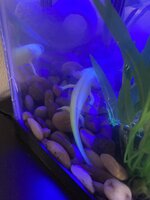Absolutely, glad I could be of some help!

On to the new questions!
Turning off your overhead at night is actually preferable; in fact, doing so will help them keep a better circadian rhythm. Axolotls are nocturnal creatures (most active at night) and if they were still in their original natural habitat, there wouldn't be any light at all other than some trace amounts from stars or the moon (when out). If you're really worried about it, I've found that my axolotl does really well when I have a nightlight in the room, but with no light directly hitting his aquarium.
For substrate, as recommended above, you can use really fine sand, though be careful to rinse it first. Basically, you want it fine enough that it won't cause digestive problems, but not do fine that it clouds the water. The easiest way to rinse sand is to put it in a bucket, grab a hose (preferably one that allows you to change the setting, you know, like "mist, shower, cone, stream," etc.--use whichever one is strongest) and agitate the sand until the water runs over the edge of the bucket clean. Once in the tank, you would have to do some routine maintenance, such as sifting through it to be sure there are no air or ammonia pockets.
I personally, however, find it easier to keep my tanks bare bottom. Some people don't like it, but I've found through some trial and error that, as long as the water flow is sufficiently low, axolotls have no problem with it and it's a LOT easier to clean.
As for food, you could probably start feeding him chunks of earthworms that are about an inch or maybe two long at that age. It might take him some getting used to, so don't give up if he doesn't take them right away, just try again the next day.
Since you haven't had your axolotl for very long, I need to ask if your tank was cycled beforehand. If you're not sure, the answer is no, and if it's not, you should be doing 50% water changes every 12 hours until it is fully cycled (aka, ammonia and nitrites need to be 0 ppm and nitrates need to be less than 40 ppm consistently). Some kind of imbalance here is the most likely reason you may be having health problems with your axolotl, but some axolotls do just really like floating around.
A water test kit is basically your most important tool (other than the aquarium) to keeping your axolotl healthy. As mentioned above, API's Masterclass Freshwater Kit is the most accurate, helpful, and cost effective kit currently on the market. It is kind of expensive up front, but it will last you about 3 or 4 years. Some pet stores do also offer free water testing, but it REALLY would be worth it to get a test kit, especially right now when you're new to everything and don't necessarily know what behaviors in your particular axolotl are unusual.
To address the bubble issue, what kind of dechlorinator are you using? Also, is there any chance a soap product may have contaminated anything in your tank?




